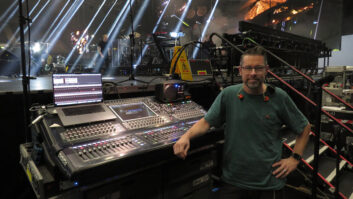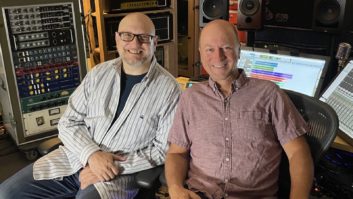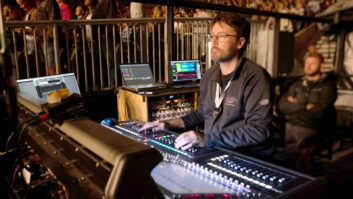

It turns out that the old saw about hard work paying off is true, as the members of Maroon 5 can attest. They spent a little more than eight months recording their latest release, It Won’t Be Soon Before Long, with three different producers in a handful of studios across Los Angeles and Las Vegas, and then scored a Platinum Number One release on the strength of the smash single “Makes Me Wonder.”
The band — vocalist/guitarist Adam Levine, keyboardist Jesse Carmichael, guitarist James Valentine, bassist Mickey Madden and new drummer Matt Flynn — started to work on this collection of songs while still supporting Songs About Jane, their multi-Platinum debut. Writing sessions spanned all sorts of locales, from the road to producer Rick Rubin’s Houdini mansion to the studio.
Maroon 5, from left: Jesse Carmichael, Mickey Madden, Adam Levine, Matthew Flynn and James Valentine
Photo: Andrew Zuckerman
All in all, reports producer Mike Elizondo, the band had around 30 songs ready to go when they were finally ready to cut the new album. However, before the band, Elizondo and engineer Mark “Spike” Stent headed into Conway Studios (L.A.), they spent a week together in rehearsals for a final bit of pre-production and finalizing arrangements. One of the things the team did was listen to songs by Michael Jackson, The Police, Prince and Talking Heads to get a vibe on how to record the tracks.
For instance, when they were working up the song “If I Never See Your Face Again,” the Jackson song “Off the Wall” was playing. “We wanted to hear the way the drums felt and the way the bass interacted with the part,” Elizondo explains. “We were using the song to say, ‘Look, every bit of this song is a hook, from the hi-hat pattern to the bass line to the clav keyboard parts to the guitar riffs.’ Then, on top of that is the ultimate vocal. It helped us gauge what the most essential bits were for each of the songs.”
Once the songs were sorted, the band headed into Conway’s Studio A. The choice of the facility was not a random one, says the band’s Carmichael, as the majority of the group had worked there with producer Rob Cavallo while they were still known as Kara’s Flowers a few years earlier. “We also recorded some demos there right before we changed the band name to Maroon 5,” he reports. “Graham Nash fronted us the money to go in there to record five songs that eventually got us signed to Octone.”
Comfort with their surroundings and a heightened level of confidence, gave the band a certain cushion. “We felt like we were much better musicians this time around, and we felt like the songs were special and that there were a lot of good emotional things represented in the songs,” Carmichael says. “We had good, diverse material, too. We all have different tastes in music.”
One of the first steps for engineer Stent was setting up two drum kits: one in the main room for a live sound and then a second in a booth for more control. He put Carmichael’s keyboards in the main room, the bass cabinets and guitar amps in two different booths, and then built a tent around Levine’s area for the vocal tracking dates.
For drum miking, Stent will typically put a Neumann FET 47 and perhaps a dynamic mic on the kick; the snare will get a Shure 57 and a Josephson; and on the toms he moved between AKG 414s, Sennheiser 421s and Neumann KM84s. “I’ll put a pair of Coles microphones literally by the drummer’s ears, set flat,” he says. “Then I may have another couple of old ribbon mics on the floor and distort the hell out of them to get a bit of grit and dirt. We also put some [Telefunken] 251s around the room to get the room sound, and then I compressed the absolute nuts out of them.”
On bass, Stent relied on Madden’s Ampeg and Aguilar setup, as well as a Line 6 bass amp combo. “I would DI that using my Pendulum preamp and a combination of a FET 47 and an [AKG] D-112,” he says. Guitar cabinets were typically miked with a combination of 57s, Josephsons and Royers. Levine and Valentine played through a handful of different amps, including classic Vox AC30s and Divided By Thirteens.
More often than not, Levine’s vocal chain started with a Blue Bottle microphone into a Neve 1081, an LA-2A and then into Pro Tools. “I tried loads of different things with him,” Stent says. “I like vocals to punch out and through. We also used a [Shure] SM7.” Depending on the song, Stent would process the vocal during tracking using the Echo Boy plug-in. During the mixing process, he might run some Logic effects in the background: “Just some distortion and bit crushes to add a bit of grit to make it punch through and dirtier.”

Although the album features an underlying programmed feel, Elizondo points out that almost everything was played live. “The band really wanted to make sure this album sounded contemporary and had that element that it was live with musicians playing,” he says. “But we took that almost Steely Dan approach of making sure that every performance was locked in and was right on the nose.”
That approach, says Carmichael, had its positives and negatives. “The top side of it is that everything is really locked down and able to stand up against all the other songs that are on the radio right now in whatever genre. For me, the downside is that a little spontaneity gets lost. It was a long process. I would say ‘painstaking’ is a good word to use, but also ‘focused’ and ‘deliberate.’”
After six months or so at Conway, the band took a break, feeling they should live with the tracks for a while to gain some perspective. “Then we regrouped at Glenwood Place Studios in Burbank [Calif.],” Elizondo says. “We rethought a couple of songs and we went back and recut about three songs.”
After the band and label took their opportunity to re-examine the recordings, producers Eric Valentine and Mark Endert were asked to lend a hand. Valentine worked on “Little of Your Time” and “Can’t Stop,” while Endert contributed his producing talents to “Makes Me Wonder” and “Back At Your Door.”
Elizondo says he understood the move. “I think if there’s one thing that Spike and I can take credit for, it’s for helping the band set up the vibe of what this record was going to be,” he says. “I think what Eric and Mark did was fantastic. After working with Spike and me for that long, it was good for the band to get that outside perspective and reassurance.”
Carmichael admits that by this time, the band had entered a delirious state. “We lost track of time, in a good way. We thought about it for so long, so hard, that finally we gave up and were really kind of loopy the last two months of recording, but it yielded some of our favorite stuff,” he says.
Valentine, who had worked with the band before when he mixed a handful of live covers for a specialty release, picked up on the vibe of the situation quickly. “As can happen on a lot of album projects, you’ll get to a certain point where there are some people that feel that it’s done and there are some people that don’t,” he says with a laugh. “They found themselves in one of those spots.”
With Valentine in the producer’s chair, the crew started on “Can’t Stop,” a song that had been worked on extensively already. The differences on the version that ended up on the release, Valentine explains, “were mostly sonic, with small embellishments here and there. There were no major composition or arrangement changes. A lot of it was subtle aesthetics. We wanted it to feel more like a high-octane rock band.”
The band’s time with Valentine — on and off for about a month at his studio, Barefoot Recording in Hollywood — was a relatively straight-ahead affair. When Endert came into the picture, though, his involvement went from remixing “Wake Up Call” to producing “Makes Me Wonder” and “Back At Your Door,” and re-cutting drums for a song or two and changing the arrangement on “If I Never See Your Face Again.”
The biggest challenge that Endert and the band faced was finding the song in “Makes Me Wonder.” The music for that track had been around for four years, but they couldn’t figure out a chorus that worked with the rest of it. “The initial demo that Adam made was minus the ‘Gimme something to believe in’ part, and we knew that something felt incomplete and so we would spend time trying to force writing a part, which never really yields anything good,” Carmichael says.
During one of the breaks in the recording process, the band headed out to Las Vegas to work in the Studio at The Palms. While working on another song, the band came up with a part they thought might work in “Wonder” if they changed the chords. “We were skeptical,” Carmichael admits, “but Mark [Endert] was a big help in tying it all together. That was the last session that we did — recording that song with Mark.”
Endert brought all the tracks into Logic to work on the arrangement and then had the band re-cut their parts. The song moved from a more rock ‘n’ roll feel to a ’70s funk vibe. “Something that sounds vintage, but modern at the same time,” he says. “Maroon’s writing style lends to that — they have a very recognizable writing style that sounds classic even though they are a new band.”

LISTEN: Must Play
Wake-Up Call







